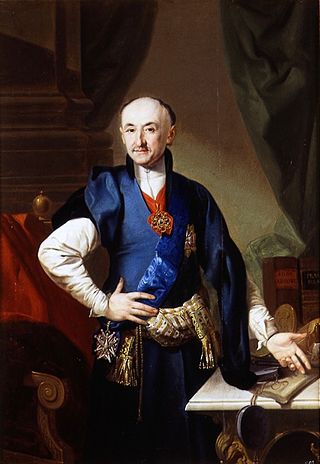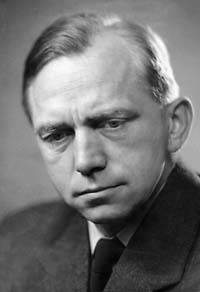This article relies largely or entirely on a single source .(May 2019) |
The Danish Chancellery (Danish : Danske Kancelli) was an administrative and partially governmental body in Denmark from the 12th century to 1848.
This article relies largely or entirely on a single source .(May 2019) |
The Danish Chancellery (Danish : Danske Kancelli) was an administrative and partially governmental body in Denmark from the 12th century to 1848.
From the 12th century to the Reformation in 1536 its name was simply the Chancellery (Danish: Kancelli). The chancellor was appointed by the king from among bishops. It had the responsibility of the expedition of letters and orders from the king. Later it also gained the responsibility of copying and archiving the king's regulations. [1]
After the Reformation the Chancellery was renamed Danish Chancellery (Danish: Danske Kancelli) to distinguish it from the German Chancellery (Danish: Tyske Kancelli). The Danish Chancellery was responsible for all correspondence in Danish and the civil administration of Denmark, Norway and Sweden. The German Chancellery had similar responsibility for the German and Latin correspondence and the civil administration of duchies of Schleswig and Holstein. Before, 1770, when it was separated into its own ministry, the German Chancellery was also responsible for foreign policy towards all but the Nordic countries. [1]
The chancellor was now a noble and not a clergyman. [1]
Over the years the chancellery gained a strong governmental power in additional to its administrative responsibilities. [1]
First mentioned in 1550s Rentekammeret (lit. Rent Chamber) was a part of the Danish Chancellery. It had the responsibility of the state financial administration. [2] Under and after Christian IV the central administration grew rapidly. Bureaus such as a postal service and customs where created. [1]
| | This section needs expansion. You can help by adding to it. (March 2019) |
At the introduction of absolute monarchy in Denmark, a number of equivalent administration and governing bodies was introduced including the War Chancellery (Danish: Krigskancelliet), and Kommercekollegiet. Rentekammeret was elevated and renamed to Skatkammerkollegiet. [1]
| Years | Danske Kansler | Notes |
|---|---|---|
| 1523-1532 | Claus Gjordsen | |
| 1533-1570 | Johan Friis til Borreby | |
| 1570(73)-1594 | Niels Kaas til Tårupgård | |
| 1594-1616 | Christian Friis til Borreby | |
| 1190-1201 | Christian Friis til Kragerup | |
| 1640-1657 | Christian Thomesen Sehested til Bækmark | |

Southern Schleswig is the southern half of the former Duchy of Schleswig in Germany on the Jutland Peninsula. The geographical area today covers the large area between the Eider river in the south and the Flensburg Fjord in the north, where it borders Denmark. Northern Schleswig, congruent with the former South Jutland County, forms the southernmost part of Denmark. The area belonged to the Crown of Denmark until Prussia and Austria declared war on Denmark in 1864. Denmark wanted to give away the German-speaking Holsten and set the new border at the small river Ejderen. Prussian chancellor Otto von Bismarck concluded that this justified a war, and even proclaimed it a "holy war". He also turned to the Emperor of Austria, Franz Joseph I of Austria for help. A similar war in 1848 had gone poorly for the Prussians. With Prussia's modern weapons and the help from both the Austrians and General Moltke, the Danish army was destroyed or forced to make a disorderly retreat. The Prussian-Danish border was then moved from the Elbe up in Jutland to the Kongeåen creek.

Frederick I was King of Denmark and Norway. He was the last Catholic monarch to reign over Denmark and Norway, when subsequent monarchs embraced Lutheranism after the Protestant Reformation. As king of Norway, Frederick is most remarkable in never having visited the country and was never crowned as such. Therefore, he was styled King of Denmark, the Vends and the Goths, elected King of Norway. Frederick's reign began the enduring tradition of calling kings of Denmark alternatively by the names Christian and Frederick.
Chancellor is a title of various official positions in the governments of many countries. The original chancellors were the cancellarii of Roman courts of justice—ushers, who sat at the cancelli of a basilica, which separated the judge and counsel from the audience. A chancellor's office is called a chancellery or chancery. The word is now used in the titles of many various officers in various settings. Nowadays the term is most often used to describe:

Carl Theodor Zahle, was a Danish lawyer and politician who served as Prime Minister of Denmark from 1909 to 1910 and again from 1913 to 1920. In 1895, he was elected as a member of the lower chamber of the Danish parliament, the Folketing, for the Liberal Party (Venstrereformpartiet). A campaigner for peace, in 1905 he co-founded the Social Liberal Party together with other disgruntled members of Venstrereformpartiet. He continued on as a member of the Folketinget for Det Radikale Venstre until 1928, when he became a member of the upper chamber of parliament (Landsting). In 1929 he became Justice Minister, a post which he held until 1935.

The Chancellor of Poland, officially, the Grand Chancellor of the Crown between 1385 and 1795, was one of the highest officials in the historic Crown of the Kingdom of Poland. This office functioned from the early Polish kingdom of the 12th century until the end of the Polish–Lithuanian Commonwealth in 1795. A respective office also existed in the Grand Duchy of Lithuania since the 16th century. Today the office of the chancellor has been replaced by that of the Prime Minister.

The Constitutional Act of the Realm of Denmark, also known as the Constitutional Act of the Kingdom of Denmark, or simply the Constitution, is the constitution of the Kingdom of Denmark, applying equally in the Realm of Denmark: Denmark proper, Greenland and the Faroe Islands. The first democratic constitution was adopted in 1849, replacing the 1665 absolutist constitution. The current constitution is from 1953. The Constitutional Act has been changed a few times. The wording is general enough to still apply today.
Oberst is a senior field officer rank in several German-speaking and Scandinavian countries, equivalent to Colonel. It is currently used by both the ground and air forces of Austria, Germany, Switzerland, Denmark, and Norway. The Swedish rank överste is a direct translation, as are the Finnish rank eversti and the Icelandic rank ofursti.

In Austria, the Ministry of the Interior is a federal government agency serving as the interior ministry of the Austrian government. It is chiefly responsible for the public security, but also deals with matters relating to citizenship, elections, referendums, plebiscites and the alternative civilian service. The Ministry of the Interior is considered one of the most important ministries in Austria

The Prime Minister's Office is the cabinet ministry of the Kingdom of Denmark, tasked with assisting the Prime Minister of Denmark, as well as the Cabinet of Denmark and Council of State.

The Danish Realm, officially the Kingdom of Denmark, or simply Denmark, is a sovereign state and refers to the area over which the monarch of Denmark is head of state. It consists of metropolitan Denmark—the kingdom's territory in continental Europe and sometimes called "Denmark proper" —and the realm's two autonomous regions: the Faroe Islands in the North Atlantic and Greenland in North America. The relationship between the three parts of the Kingdom is also known as The unity of the Realm.

The Federal Chancellery of Switzerland is a department-level agency of the federal administration of Switzerland. It is the staff organisation of the federal government, the Federal Council. Since 2024, it has been headed by Federal Chancellor Viktor Rossi of the Green Liberal Party of Switzerland.

Denmark–Norway is a term for the 16th-to-19th-century multi-national and multi-lingual real union consisting of the Kingdom of Denmark, the Kingdom of Norway, the Duchy of Schleswig, and the Duchy of Holstein. The state also claimed sovereignty over three historical peoples: Frisians, Gutes and Wends. Denmark–Norway had several colonies, namely the Danish Gold Coast, the Nicobar Islands, Serampore, Tharangambadi, and the Danish West Indies. The union was also known as the Dano-Norwegian Realm, Twin Realms (Tvillingerigerne) or the Oldenburg Monarchy (Oldenburg-monarkiet).

Povel Ottesen Huitfeldt was the first Danish-Norwegian Governor-general of Norway.

Ove Iversen Juul was a Danish nobleman who served as Vice Governor-general of Norway under Ulrik Fredrik Gyldenløve from 1669 to 1674.
The Ranks and insignia of Royal Danish Army follows the NATO system of ranks and insignia, as does the rest of the Danish Defence. The ranks are based around German and French military terms.

The Marshal of the Realm, was the chief advisor to the King on military matters concerning the infantry and cavalry. It was the third highest office in the country after the Steward of the Realm and the Chancellor. The Rigsmarsk was appointed by the king from among Danish-born nobles.

Alfred Martin Jens Hansen (20 August 1909 – 27 June 1955) was a Danish writer who wrote under the name Martin A. Hansen. He is known for his writings as a member of the Danish resistance movement during the German occupation of Denmark in WWII.

The Danish Civil Wars were a series of civil wars fought in the Kingdom of Denmark, first from 1131 to 1134 over the murder of Canute Lavard, then from 1139 to 1143, and finally a war of succession fought from 1146 to 1157, after the abdication of Eric III of Denmark, the first monarch in Danish history to have abdicated. The first phase of the war was fought between King Eric II of Denmark and King Niels joined by Magnus the Strong. The second phase of the war was fought between the son of Magnus the Strong, Canute V of Denmark, the son of Eric II of Denmark, Sweyn III of Denmark, and his cousin Valdemar I of Denmark, son of Canute Lavard. The civil wars marked an increase in the influence of the Holy Roman Empire in Denmark, and for a time after, Denmark was a vassal state of Emperor Frederick I. The war ended with the deaths of seven kings. Two of the kings, Olaf Haraldsen and Magnus the Strong, are not amongst the official Danish line of kings. The other kings are Niels I, Eric II, Eric III, Canute V and Sweyn III.
The Rentekammeret was the Danish central administrative body responsible for overseeing the public finances from the middle of the 15th century until 1849. The chief officials of Rentekammeret held the title of Rentemester (Treasurer).
Christopher Schøller Bülow was a Danish landowner who served as prefect (stiftsamtmand) of Diocese of Zealand and county governor of Copenhagen County. He went bankrupt in 1818 and fled the country after being convicted of embezzlement. He died in Hamburg.